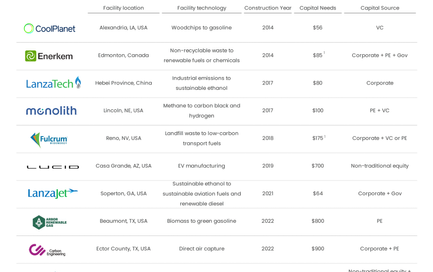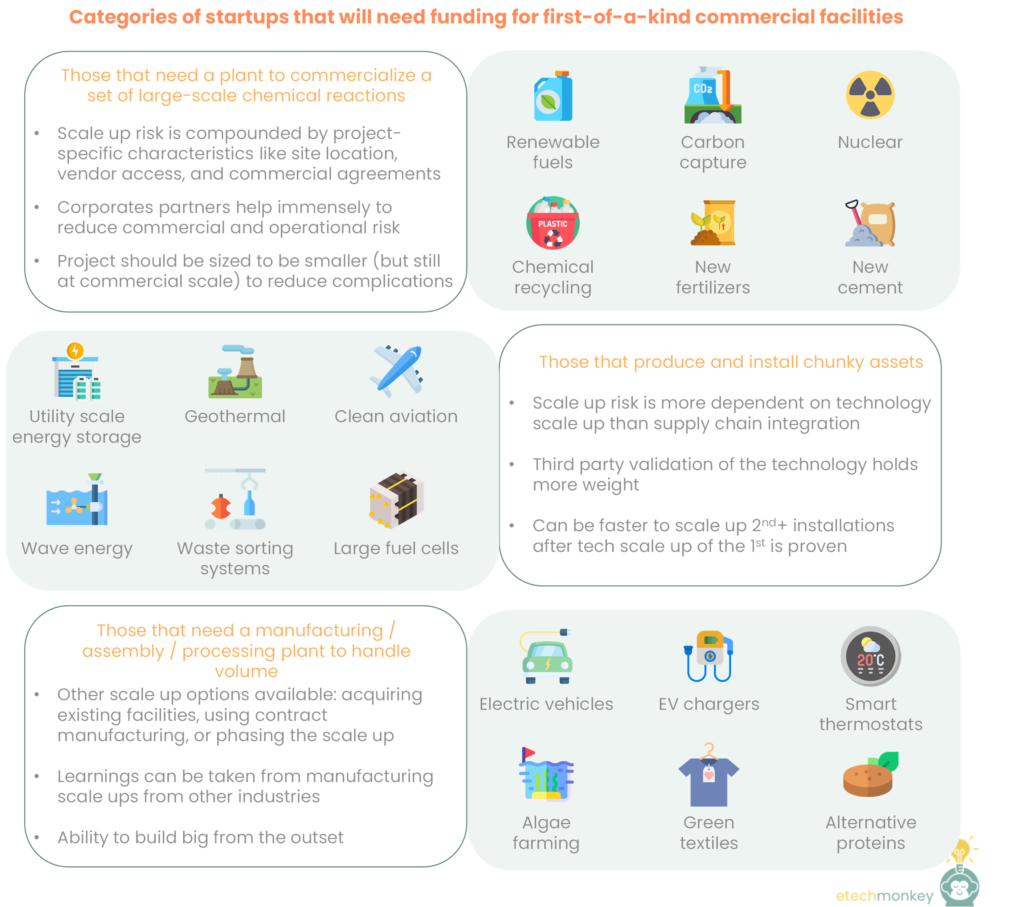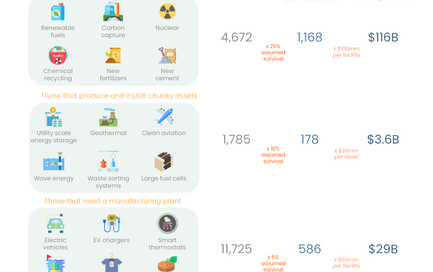
3 different types of first commercial facilities

After last week’s look at commercial facilities that have been successfully funded, I wanted to better understand what projects in the future will need large first commercial facility (or large first-of-a-kind / FOAK for short) funding.
I went through the list of hard-tech climatetech technologies and think there's ultimately 3 types of startups that will need FOAK funding.
In order from most scale up risk to least scale up risk, assuming technology risk is equal:
- Those that need a plant to commercialize a set of large-scale chemical reactions – in other words, startups which have chemical processes at the core of the plant. Because these reactions require feedstock and offtake, the scale up risk is compounded by project-specific characteristics like site location, vendor access, and commercial agreements. Many of these projects find ways to attach themselves to an existing plant or asset to reduce this risk. There is also generally more uncertainty with a chemistry-based scale up as many things are environmentally sensitive and small changes can produce no product or unwanted product.
This category typically includes renewable fuels, carbon capture, oxycombustion, pyrolysis, low carbon concrete, low carbon steel, chemical recycling, nuclear, new fertilizers - Those that produce and install chunky assets – in other words, startups that rely on deploying big installations. The FOAK project is a single asset produced at a scale large enough to be commercially viable. The scale up risk in this case is less dependent on integration with the supply chain / commercial agreements around the project and more on the pure engineering of scaling up the technology itself. This simplifies the scale up a little more compared to #1 but also puts the onus of whether a project works on the technology. Since there are usually fewer third party companies involved in this type of project than in #1, third party validation of the technology holds more weight in derisking the project for an investor.
This category typically includes utility scale energy storage, geothermal, carbon storage, clean aviation, concentrated solar power, wave energy, automated mining, automated waste sorting, hydrogen electrolyzers, hydrogen fuel cells - Those that need a manufacturing / assembly / processing plant designed to handle volume – in other words, startups that have a need to produce product in large volumes. This is by far the largest category in terms of number of startups that could grow to need this kind of project. BUT this is also the category that may not require complete FOAK funding if the startups 1) successfully use contract manufacturing, 2) outsource most of the manufacturing and only need a small facility for assembly, or 3) acquire an existing manufacturing facility that produces a similar or adjacent product. Manufacturing is also arguably the easiest to scale up out of the three categories since there is less a scale up of technology and more a scale up of process, something which also has plenty of precedence in other industries.
This category typically includes EV batteries and battery components, EVs, EV retrofits, EV chargers, heat pumps, smart thermostats, smart glass, soil sensors, e-scooters, e-bikes, green textiles, algae farms, new photovoltaics, alternative proteins
These categories aren’t necessarily mutually exclusive. A company that builds an automated waste sorting facility may also need a manufacturing facility for robots (see AMP Robotics). A company that that installs large flared gas-to-datacenter systems may also want to manufacture its data centers (see Crusoe). (By the way, these two were not included in last week’s list because their FOAKs were <$50mm.) But most startups that are still commercializing their technologies are only contemplating FOAK in one of the three categories.
So what’s the point in knowing these categories? Understanding which category a startup lands in when planning out a FOAK commercial project can help identify a peer group with a similar scale up risk profile. Perhaps there are milestones and timelines that can be informative for early stage project planning, best practices that can be used between companies in each category, or benchmarks that can be used to help pitch the project risk profile to investors. Since the universe of FOAK commercial is so limited in climatetech, being able to creatively find a peer group to help tell the story is more important than in other industries.
There are also different recommendations I would make for capital raising in each category:
Those that need a plant:
- Plan out the feedstock / offtake carefully; if possible, secure the commercial terms on these agreements prior to fundraising
- Try to find corporate partners or co-locate the project with an existing facility reduce project-specific risks
- Since there are so many moving pieces with these projects, keep the first commercial scale up on the smaller side (while also making sure it’s economic) to reduce risk of complications
Those that need a large installation:
- Get third party validation of the technology and/or technology scale up to compensate for fewer involved parties
- Find corporate partners if they can help provide third party technology validation and/or reduce the cost of capital for a project
- Plan out the next few installations as part of the story; since large installations are less dependent on supply chain integration/commercial terms and thus can be deployed quickly, have a plan to accelerate deployment once the technology is proven in the FOAK installation
Those that need a manufacturing facility:
- Look to other industries for manufacturing scale up examples, especially if an adjacent product is already being produced
- Look for alternative ways of scaling manufacturing – acquiring existing facilities that build similar products, utilizing contract manufacturing, or phasing the scale up can all be ways to avoid the FOAK problem
- Build big; because the manufacturing scale up is more straightforward than that of the other two categories, startups have the luxury of choosing to scale big from the outset. Building for strong future growth can help avoid having to build another plant in the future + takes advantage of economies of scale
Would love to hear:
If you're a startup - does this framework make sense to you? Or is there another category that's missing? If you're looking for FOAK funding or thinking about your FOAK plans in the future, I would love to connect.
If you're an investor - are there different or additional recommendations you would give for each of these categories?
If you're part of a corporate - are you or have you contemplated the types of partnerships described above?


